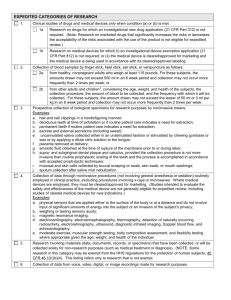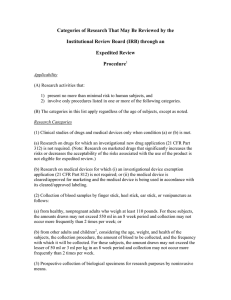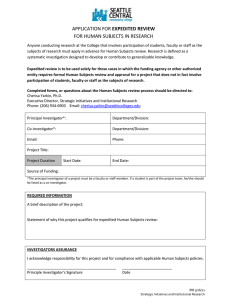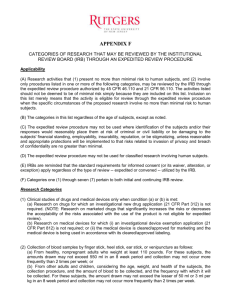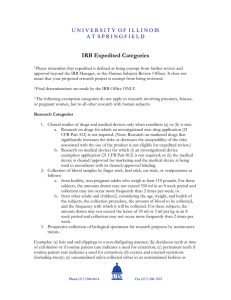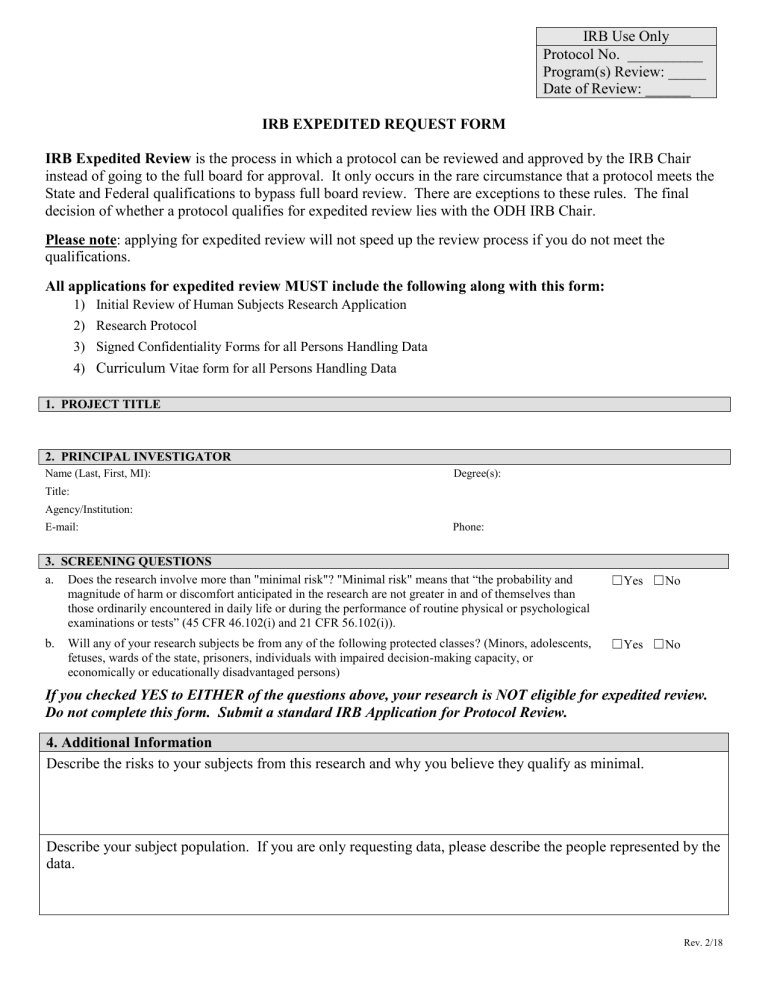
IRB Use Only Protocol No. __________ Program(s) Review: _____ Date of Review: ______ IRB EXPEDITED REQUEST FORM IRB Expedited Review is the process in which a protocol can be reviewed and approved by the IRB Chair instead of going to the full board for approval. It only occurs in the rare circumstance that a protocol meets the State and Federal qualifications to bypass full board review. There are exceptions to these rules. The final decision of whether a protocol qualifies for expedited review lies with the ODH IRB Chair. Please note: applying for expedited review will not speed up the review process if you do not meet the qualifications. All applications for expedited review MUST include the following along with this form: 1) Initial Review of Human Subjects Research Application 2) Research Protocol 3) Signed Confidentiality Forms for all Persons Handling Data 4) Curriculum Vitae form for all Persons Handling Data 1. PROJECT TITLE 2. PRINCIPAL INVESTIGATOR Name (Last, First, MI): Degree(s): Title: Agency/Institution: E-mail: Phone: 3. SCREENING QUESTIONS a. Does the research involve more than "minimal risk"? "Minimal risk" means that “the probability and magnitude of harm or discomfort anticipated in the research are not greater in and of themselves than those ordinarily encountered in daily life or during the performance of routine physical or psychological examinations or tests” (45 CFR 46.102(i) and 21 CFR 56.102(i)). b. Will any of your research subjects be from any of the following protected classes? (Minors, adolescents, fetuses, wards of the state, prisoners, individuals with impaired decision-making capacity, or economically or educationally disadvantaged persons) ☐Yes ☐No ☐Yes ☐No If you checked YES to EITHER of the questions above, your research is NOT eligible for expedited review. Do not complete this form. Submit a standard IRB Application for Protocol Review. 4. Additional Information Describe the risks to your subjects from this research and why you believe they qualify as minimal. Describe your subject population. If you are only requesting data, please describe the people represented by the data. Rev. 2/18 5. EXPEDITED CATEGORY Please check the category of expedited review for which you are applying. You may check more than one box. 1☐ 2☐ 3☐ 4☐ 5☐ 6☐ 7☐ Describe how your request meets the category(ies) you checked. EXPEDITED REVIEW CATEGORIES (1) Clinical studies of drugs and medical devices only when condition (a) or (b) is met. (a) Research on drugs for which an investigational new drug application (21 CFR 312) is not required. (Note: Research on marketed drugs that significantly increases the risks or decreases the acceptability of the risks associated with the use of the product is not eligible for expedited review.) (b) Research on medical devices for which (i) an investigational device exemption application (21 CFR 812) is not required; or (ii) the medical device is cleared/approved for marketing and the medical device is being used in accordance with its cleared/approved labeling. (2) Collection of blood samples by finger stick, heel stick, ear stick, or venipuncture as follows: (a) from healthy, non-pregnant adults who weigh at least 110 pounds. For these participants, the amounts drawn may not exceed 550 ml in an 8 week period and collection may not occur more frequently than 2 times per week. (b) from other adults and children (defined as “persons who have not attained the legal age for consent to treatments or procedures involved in the research, under the applicable law of the jurisdiction in which the research will be conducted.” 45 CFR 46.402(a)), considering the age, weight, and health of the participants, the collection procedure, the amount of blood to be collected, and the frequency with which it will be collected. For these participants, the amount drawn may not exceed the lesser of 50 ml or 3 ml per kg in an 8 week period and collection may not occur more frequently than 2 times per week. (3) Prospective collection of biological specimens for research purposes by non-invasive means. Examples: (a) hair and nail clippings in a non-disfiguring manner; (b) deciduous teeth at time of exfoliation or if routine patient care indicates a need for extraction; (c) permanent teeth if routine patient care indicates a need for extraction; (d) excreta and external secretions (including sweat); (e) uncannulated saliva collected either in an unstimulated fashion or stimulated by chewing gumbase or wax or by applying a dilute citric solution to the tongue; (f) placenta removed at delivery; (g) amniotic fluid obtained at the time of rupture of the membrane prior to or during labor; (h) supra- and subgingival dental plaque and calculus, provided the collection procedure is not more invasive than routine prophylactic scaling of the teeth and the process is accomplished in accordance with accepted prophylactic techniques; (i) mucosal and skin cells collected by buccal scraping or swab, skin swab, or mouth washings; (j) sputum collected after saline mist nebulization. (4) Collection of data through noninvasive procedures (not involving general anesthesia or sedation) routinely employed in clinical practice, excluding procedures involving x-rays or microwaves. Where medical devices are employed, they must be cleared/approved for marketing. (Studies intended to evaluate the safety and effectiveness of the medical device are not generally eligible for expedited review, including studies of cleared medical devices for new indications.) Examples: (a) physical sensors that are applied either to the surface of the body or at a distance and do not involve input of significant amounts of energy into the participant or an invasion of the participant’s privacy; (b) weighing or testing sensory acuity; (c) magnetic resonance imaging; (d) electrocardiography, electroencephalography, thermography, detection of naturally occurring radioactivity, electroretinography, ultrasound, diagnostic infrared imaging, doppler blood flow, and echocardiography; (e) moderate exercise, muscular strength testing, body composition assessment, and flexibility testing where appropriate given the age, weight, and health of the individual. (5) Research involving materials (data, documents, records, or specimens) that have been collected or will be collected solely for non-research purposes (such as medical treatment or diagnosis). (NOTE: Some research in this category may be exempt from the HHS regulations for the protection of human subjects 45 CFR 46.101(b)(4). This listing refers only to research that is not exempt.) PLEASE NOTE: Data collected for research purposes doesn’t qualify under this category. (6) Collection of data from voice, video, digital or image recordings made for research purposes. (7) Research made on individual or group characteristics or behavior (including, but not limited to, research on perception, cognition, motivation, identity, language, communication, cultural beliefs or practices, and social behavior) or research employing survey, interview, oral history, focus group, program evaluation, human factors evaluation, or quality assurance methodologies. (NOTE: Some research in this category may be exempt from the HHS regulations for the protection of human subjects 45 CFR 46.101 (b)(2) and (b)(3). This listing refers only to research that is not exempt.) 6. ASSURANCE: PRINCIPAL INVESTIGATOR (or Advisor) I agree to follow all applicable federal regulations, guidance, and state and local laws related to the protection of human subjects in research, as well as professional practice standards and generally accepted good research practices for investigators. I verify that the information provided in this Application for expedited review is accurate and complete. I will initiate this research only after having received notification of approval. Signature of Principal Investigator Printed name of Principal Investigator Date
